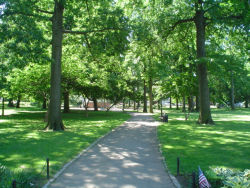Westerleigh Park
Westerleigh Park
What was here before?
First purchased in 1848 by John Vanderbilt, the land was sold to the National Prohibition Party in 1887 to create a summer retreat. By July 1888, the National Prohibition Campground Association had built a large 15-acre camping facility for members of the Party and followers of the Prohibition Movement. This period was the height of the anti-alcohol movement, and the campground was busy with meetings, lectures, religious services, and recreational activities.
Camp visitor ship declined slowly and Westerleigh transitioned from a tent-dotted summer community to a year-round neighborhood with the addition of permanent streets and sidewalks. Many Dutch Colonial and Victorian houses characteristic of those times remain in the area.
How did this site become a park?
The site was donated to the City in 1907 by the National Prohibition Park Company with the understanding that it would be used for public recreational purposes and events. At that time, it was a part of the 15-acre ‘picnic grove,’ or ‘pleasure grove’ of the National Prohibition Park complex. In 1923, the Staten Island Parks Department constructed a large octagonal bandstand in the park. Concerts in Westerleigh Park quickly became popular, drawing crowds of up to 500. The popularity of Westerleigh Park’s concerts has continued throughout the 20th century.
Who is this park named for?
Previously known as National Prohibition Park, the surrounding neighborhood gradually became known as Westerleigh, after the Westerleigh Collegiate Institute of Staten Island, once located nearby before it was destroyed in a fire. Founded in 1895, it was the first school on Staten Island to provide a complete kindergarten to college education.
Check out your park's Vital Signs
Clean & Safe
Green & Resilient
Empowered & Engaged Users
Share your feedback or learn more about how this park is part of a
Vital Park System



